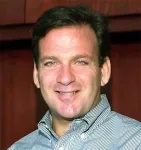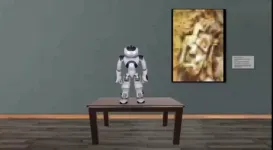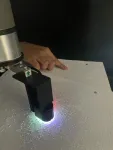(Press-News.org) The number of people with obesity has nearly tripled since 1975, resulting in a worldwide epidemic. While lifestyle factors like diet and exercise play a role in the development and progression of obesity, scientists have come to understand that obesity is also associated with intrinsic metabolic abnormalities. Now, researchers from University of California San Diego School of Medicine have shed new light on how obesity affects our mitochondria, the all-important energy-producing structures of our cells.
In a study published January 29, 2023 in Nature Metabolism, the researchers found that when mice were fed a high-fat diet, mitochondria within their fat cells broke apart into smaller mitochondria with reduced capacity for burning fat. Further, they discovered that this process is controlled by a single gene. By deleting this gene from the mice, they were able to protect them from excess weight gain, even when they ate the same high-fat diet as other mice.
“Caloric overload from overeating can lead to weight gain and also triggers a metabolic cascade that reduces energy burning, making obesity even worse,” said Alan Saltiel, PhD, professor in the Department of Medicine at UC San Diego School of Medicine. “The gene we identified is a critical part of that transition from healthy weight to obesity.”
Obesity, which affects more than 40% of adults in the United States, occurs when the body accumulates too much fat, which is primarily stored in adipose tissue. Adipose tissue normally provides important mechanical benefits by cushioning vital organs and providing insulation. It also has important metabolic functions, such as releasing hormones and other cellular signaling molecules that instruct other tissues to burn or store energy.
In the case of caloric imbalances like obesity, the ability of fat cells to burn energy starts to fail, which is one reason why it can be difficult for people with obesity to lose weight. How these metabolic abnormalities start is among the biggest mysteries surrounding obesity.
To answer this question, the researchers fed mice a high-fat diet and measured the impact of this diet on their fat cells’ mitochondria, structures within cells that help burn fat. They discovered an unusual phenomenon. After consuming a high-fat diet, mitochondria in parts of the mice’s adipose tissue underwent fragmentation, splitting into many smaller, ineffective mitochondria that burned less fat.
In addition to discovering this metabolic effect, they also discovered that it is driven by the activity of single molecule, called RaIA. RaIA has many functions, including helping break down mitochondria when they malfunction. The new research suggests that when this molecule is overactive, it interferes with the normal functioning of mitochondria, triggering the metabolic issues associated with obesity.
“In essence, chronic activation of RaIA appears to play a critical role in suppressing energy expenditure in obese adipose tissue,” said Saltiel. “By understanding this mechanism, we’re one step closer to developing targeted therapies that could address weight gain and associated metabolic dysfunctions by increasing fat burning."
By deleting the gene associated with RaIA, the researchers were able to protect the mice against diet-induced weight gain. Delving deeper into the biochemistry at play, the researchers found that some of the proteins affected by RaIA in mice are analogous to human proteins that are associated with obesity and insulin resistance, suggesting that similar mechanisms may be driving human obesity.
“The direct comparison between the fundamental biology we’ve discovered and real clinical outcomes underscores the relevance of the findings to humans and suggests we may be able to help treat or prevent obesity by targeting the RaIA pathway with new therapies,” said Saltiel “We’re only just beginning to understand the complex metabolism of this disease, but the future possibilities are exciting.”
Co-authors of the study include: Wenmin Xia, Preethi Veeragandham, Yu Cao Yayun Xu, Torrey Rhyne, Jiaxin Qian, Ying Jones,Chao-Wei Hung, Zichen Wang, Hiroyuki Hakozaki and Johannes Schoneberg at UC San Diego, Peng Zhao at University of Texas Health Science Center, Hui Gao and Mikael Ryden at Karolinska Institute, Christopher Liddle, Ruth Yu, Michael Downes, Ronald Evans and Jianfeng Huang at Salk Institute for Biological Studies,Martin Wabitsch at Ulm University Medical Center and Shannon Reilly at Weill Medical College of Cornell University.
This study was funded, in part, by the National Institutes of Health (Grants P30DK063491, R01DK122804, R01DK124496, R01DK125820 and R01DK128796).
# # #
END
How obesity dismantles our mitochondria
UC San Diego Study reveals key mechanism behind obesity-related metabolic dysfunction
2024-01-29
ELSE PRESS RELEASES FROM THIS DATE:
Cancer treatment two and a half times more effective when tumours have defective "energy factories"
2024-01-29
Cancer Research UK-funded scientists have made an unusual discovery that could help to identify patients who are up to two and a half times more likely to respond to currently available cancer drugs.
Scientists at the Cancer Research UK Scotland Institute and Memorial Sloan Kettering Cancer Centre in the USA have “rewired” the DNA of mitochondria – energy factories found in every living cell. They found that creating mutations in parts of this DNA determines how well cancer will respond to immunotherapy – treatments which harness the body’s natural defences ...
How does a “reverse sprinkler” work? Researchers solve decades-old physics puzzle
2024-01-29
For decades scientists have been trying to solve Feynman’s Sprinkler Problem: How does a sprinkler running in reverse—in which the water flows into the device rather than out of it—work? Through a series of experiments, a team of mathematicians has figured out how flowing fluids exert forces and move structures, thereby revealing the answer to this long-standing mystery.
“Our study solves the problem by combining precision lab experiments with mathematical modeling that explains how a reverse sprinkler operates,” explains Leif Ristroph, an associate professor at New York University’s Courant Institute of Mathematical Sciences and the senior author ...
Neuroblastoma: Liquid biopsies to detect relapse of childhood cancer early
2024-01-29
(Utrecht/Vienna, 29.1.2024) Neuroblastoma mainly affects toddlers and young children - in the EU region there are 1500 new cases per year. Neuroblastoma is a malignant tumor of the peripheral nervous system and around 50% of patients are high-risk cases. Recurrences occur frequently, and conventional therapies are no longer effective for these children. With liquid biopsies it is possible to monitor therapy success and to predict the recurrence of the tumor in time to take medical countermeasures. Scientists from leading European ...
Speaking in a local accent might make social robots seem more trustworthy and competent
2024-01-29
Social robots can help us with many things: teaching, learning, caring. Because they’re designed to interact with humans, they’re designed to make us comfortable — and that includes the way they talk. But how should they talk? Some research suggests that people like robots to use a familiar accent or dialect, while other research suggests the opposite.
“Surprisingly, people have mixed feelings about robots speaking in a dialect — some like it, while others prefer standard language,” said Katharina Kühne of the University of Potsdam, lead author ...
Hybrid energy harvesters that harness heat and vibration simultaneously
2024-01-29
Harvesting energy sources such as heat, vibration, light, and electromagnetic waves from everyday environments such as industrial sites and automobiles and converting them into electrical energy is known as energy harvesting. Energy harvesting makes it easier to power today's popular IoT sensors and wireless devices that are located in environments where battery replacement is difficult.
Dr. Hyun-Cheol Song and Dr. Sunghoon Hur of Electronic Materials Research Center at the Korea Institute of Science and Technology (KIST) have developed a hybrid energy harvesting ...
Organ donations after MAiD made up 14% of deceased donations in Quebec
2024-01-29
Organ donation after medical assistance in dying (MAiD) represented 14% of Quebec's total deceased donations in 2022, according to a new study in CMAJ (Canadian Medical Association Journal) https://www.cmaj.ca/lookup/doi/10.1503/cmaj.230883.
To understand the impact of organ donation after MAiD, Quebec researchers analyzed data on all patients referred to Transplant Québec for possible organ donation after MAiD from January 2018 to December 2022. This represented the first 5 full years when organ donation after MAiD was allowed in the province. Over the 5-year period, Transplant Québec received 245 referrals for donation after MAiD, ...
Polycystic ovarian syndrome: new review to help diagnose and manage
2024-01-29
A new review in CMAJ (Canadian Medical Association Journal) is aimed at helping clinicians diagnose and manage polycystic ovarian syndrome (PCOS), an endocrine disorder that affects about 10% of femaleshttps://www.cmaj.ca/lookup/doi/10.1503/cmaj.231251.
This disorder affects females of reproductive age and is associated with infertility, miscarriage and pregnancy complications. Its long-term health consequences include hypertension, cancer risks, and metabolic and psychological impacts. Patients usually present to health care between ages 18 and 39 years complaining of menstrual cycle irregularities, ...
Robot trained to read braille at twice the speed of humans
2024-01-29
Researchers have developed a robotic sensor that incorporates artificial intelligence techniques to read braille at speeds roughly double that of most human readers.
The research team, from the University of Cambridge, used machine learning algorithms to teach a robotic sensor to quickly slide over lines of braille text. The robot was able to read the braille at 315 words per minute at close to 90% accuracy.
Although the robot braille reader was not developed as an assistive technology, the researchers say the high sensitivity required to read braille makes it an ideal test in the development of robot ...
Obesity and alcohol are contributing to increases in bowel cancer rates among young adults
2024-01-29
Overweight and obesity are contributing to rising death rates from bowel cancer among people aged 25-49 years in the European Union (EU) and the UK, although death rates from this type of cancer are decreasing overall across Europe.
These findings are from a new study published in the leading cancer journal Annals of Oncology [1] today (Monday), which predicts death rates from cancer in the EU and UK for 2024. It is the first time that an increase in bowel cancer death rates among young adults has been predicted for the EU, and it confirms a trend in the UK that the researchers first noted in 2021.
Researchers led by Carlo La Vecchia (MD), ...
Playing an instrument linked to better brain health in older adults
2024-01-29
Engaging in music throughout your life is associated with better brain health in older age, according to a new study published by experts at the University of Exeter.
Scientists working on PROTECT, an online study open to people aged 40 and over, reviewed data from more than a thousand adults over the age of 40 to see the effect of playing a musical instrument – or singing in a choir - on brain health. Over 25000 people have signed up for the PROTECT study, which has been running for 10 years.
The team reviewed participants’ musical experience and lifetime exposure ...
LAST 30 PRESS RELEASES:
Sleeping in on weekends may help boost teens’ mental health
Study: Teens use cellphones for an hour a day at school
After more than two years of war, Palestinian children are hungry, denied education and “like the living dead”
The untold story of life with Prader-Willi syndrome - according to the siblings who live it
How the parasite that ‘gave up sex’ found more hosts – and why its victory won’t last
When is it time to jump? The boiling frog problem of AI use in physics education
Twitter data reveals partisan divide in understanding why pollen season's getting worse
AI is quick but risky for updating old software
Revolutionizing biosecurity: new multi-omics framework to transform invasive species management
From ancient herb to modern medicine: new review unveils the multi-targeted healing potential of Borago officinalis
Building a global scientific community: Biological Diversity Journal announces dual recruitment of Editorial Board and Youth Editorial Board members
Microbes that break down antibiotics help protect ecosystems under drug pollution
Smart biochar that remembers pollutants offers a new way to clean water and recycle biomass
Rice genes matter more than domestication in shaping plant microbiomes
Ticking time bomb: Some farmers report as many as 70 tick encounters over a 6-month period
Turning garden and crop waste into plastics
Scientists discover ‘platypus galaxies’ in the early universe
Seeing thyroid cancer in a new light: when AI meets label-free imaging in the operating room
Neutrophil-to-lymphocyte ratio may aid risk stratification in depressive disorder
2026 Seismological Society of America Annual Meeting
AI-powered ECG analysis offers promising path for early detection of chronic obstructive pulmonary disease, says Mount Sinai researchers
GIMM uncovers flaws in lab-grown heart cells and paves the way for improved treatments
Cracking the evolutionary code of sleep
Medications could help the aging brain cope with surgery, memory impairment
Back pain linked to worse sleep years later in men over 65, according to study
CDC urges ‘shared decision-making’ on some childhood vaccines; many unclear about what that means
New research finds that an ‘equal treatment’ approach to economic opportunity advertising can backfire
Researchers create shape-shifting, self-navigating microparticles
Science army mobilizes to map US soil microbiome
Researchers develop new tools to turn grain crops into biosensors
[Press-News.org] How obesity dismantles our mitochondriaUC San Diego Study reveals key mechanism behind obesity-related metabolic dysfunction






